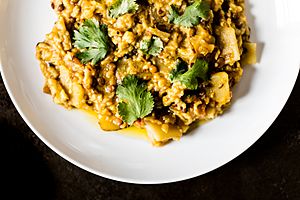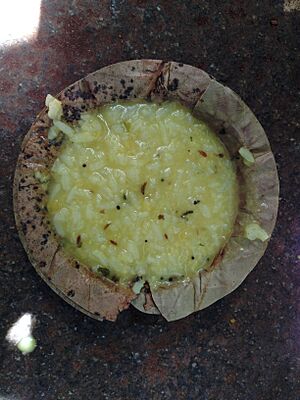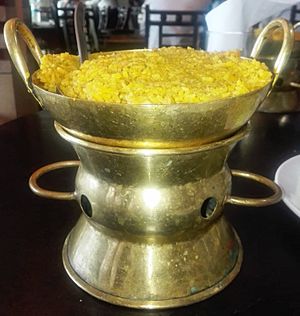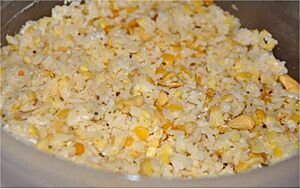Khichdi (dish) facts for kids
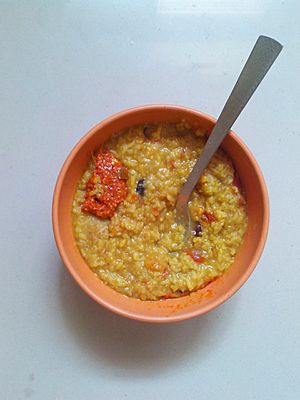
A bowl of dal khichri served with achar
|
|
| Alternative names | Khichdi, khichadi, khichdee, khichadi, khengchuri (Bengali), khisiri (Assamese), khechidi/khechudi (Odia), kisuri (Sylheti), khichari, kitcheree, kitchree |
|---|---|
| Region or state | Indian Subcontinent |
| Associated national cuisine | India, Bangladesh, Pakistan, Nepal, Trinidad and Tobago, Guyana, Suriname, Fiji, Mauritius |
| Main ingredients | Rice, lentils, spices |
| Variations | Mung dal khichri, bajra-ri-khichri (Rajasthani millet khichri), sadi khichri (lentil and rice khichri) |
Khichdi or khichri is a popular dish from the Indian subcontinent. It is mainly made from rice and lentils (called dal). There are many different ways to make it, like using bajra or mung dal.
In Indian culture, especially in northern areas, Khichdi is often one of the first solid foods that babies eat. It's a savory (salty) porridge.
Contents
Where the Name Comes From
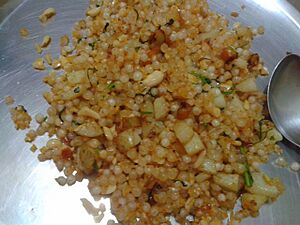
The word Khichdi comes from the ancient Sanskrit word khiccā. This word describes a dish made from rice and legumes (like lentils).
Khichdi Through Time
Khichdi has a long and interesting history!
- Around 305-303 BC, a Greek king named Seleucus visited India. He wrote that rice mixed with pulses (like lentils) was very popular among the people.
- Later, in the 1300s, a traveler named Ibn Battuta mentioned khichdi in his writings about India. He described it as a dish made of rice and mung beans.
- In the 15th century, a Russian adventurer named Afanasy Nikitin also wrote about khichdi after his travels in the Indian subcontinent.
- The dish was very popular with the Mughal emperors, especially Jahangir.
- A famous 16th-century book called Ain-i-Akbari, written by Emperor Akbar's advisor, Abu'l-Fazl ibn Mubarak, even shares seven different recipes for khichdi! There's even a fun story about Akbar, his clever advisor Birbal, and khichdi.
- The Anglo-Indian dish called Kedgeree is believed to have come from khichdi.
Different Kinds of Khichdi
Khichdi is super popular all over the Indian subcontinent. You can find it in Bangladesh, Nepal, and Pakistan, as well as many states in India.
- Common additions: People often add vegetables like cauliflower, potatoes, and green peas to their khichdi.
- Fasting food: Many Hindus eat Sabudana khichri during fasts. This special khichdi is made from sago instead of grains.
- Southern India: In southern India, similar dishes exist but might have different names. For example, in Tamil Nadu, they have Pongal. In Karnataka, they make Huggi (a mung dal khichdi) and Bisi bele bhath (which uses pigeon peas and vegetables).
- Haryana's Khichdi: In the rural areas of Haryana, Haryanvi khichdi is a traditional favorite. It's made from pearl millet and mung dal that's pounded. People often eat it with warm ghee (clarified butter) or lassi (a yogurt drink). Sometimes, jowar (another grain) is also added.
- Hyderabadi Breakfast: The Hyderabadi Muslim community often eats khichdi for breakfast. Their meal usually includes khichri, ground beef (called kheema), and a sour sauce made from tamarind and sesame.
It's important to know that Khichra is a meat dish, similar to haleem. But khichri is a vegetarian dish made with rice and lentils, usually without strong spices.
Khichdi in Pop Culture
Khichdi is so well-known that its name has been used for movies and TV shows that feature a mix of different things or characters.
- There's a movie called Khichdi: The Movie.
- There are also TV sitcoms like Khichdi (franchise), Khichdi (TV series), and Instant Khichdi.
- This dish has even been cooked on famous cooking shows like MasterChef Australia and MasterChef America!
See also
 In Spanish: Khichdi para niños
In Spanish: Khichdi para niños


